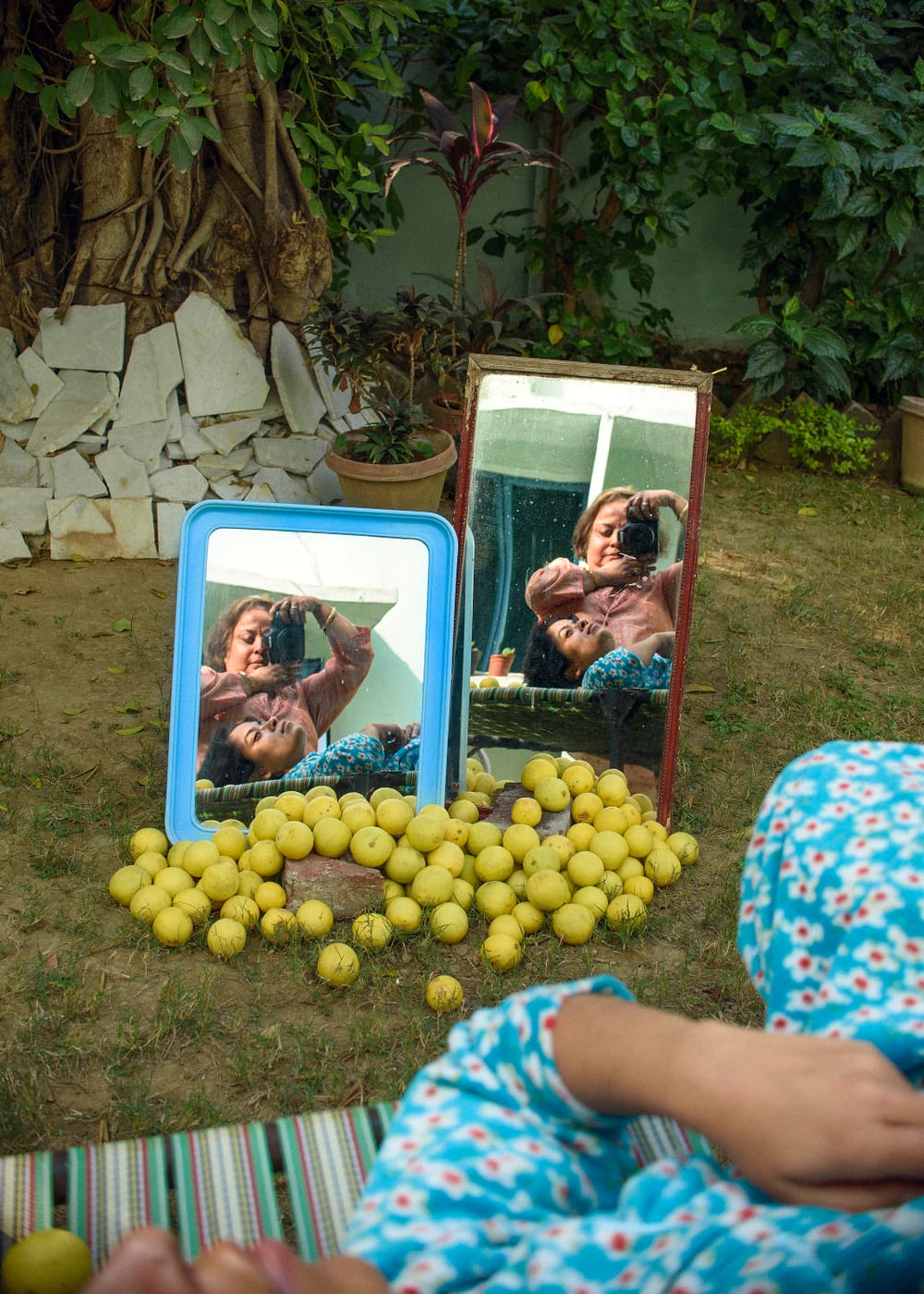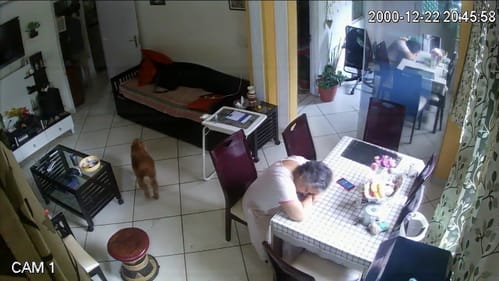Stay in the Loop
BSR publishes on a weekly schedule, with an email newsletter every Wednesday and Thursday morning. There’s no paywall, and subscribing is always free.
The Light Outside Home, and other works on trauma and memory
The Print Center presents its 97th Annual International Competition

Cheryl Mukherji memorializes an incident no one would want to remember: “424 days ago, I held a white hand towel against my mother’s bloody forehead.” The incident, and Mukherji’s relationship with her mother, compose Ghorer Bairer Aalo (The Light Outside Home), one of three solo exhibits capping the Print Center’s 97th Annual International Competition.
Mukherji’s The Last Time (2020) probes her mother’s self-inflicted injury. A dozen vellum pages, layered with screen-print images and typewriter text, replicate the way we relive terrible memories—in disjointed flashes, vividly recalling inconsequential details, viewing events as an onlooker. Glimpses swirl through pages printed in blue, red, and green. There’s Mukherji, a toddler supported by her mother’s hands. Both look up at the camera, eyes wide with excitement. Then she’s a girl in ceremonial dress, smiling as the same hands that held her upright arrange flowers around her neck. Next, she’s a serious adolescent, staring into the camera.
The second page lays out what happened in 2018, shortly before Mukherji relocated from her native India to the United States: “I was sitting at the dinner table when my mother started getting upset about how no one really loved her. I did not pay attention to what she was saying because she said it too often and then went on with her day normally.” But that day, her mother harmed herself.
Outside the family album
Fragments of the story recur through the exhibit, which includes work on paper, video, and at the center of the gallery, a block of yellowed resin holding a square of stained white cotton.
Mukherji’s art confronts what doesn’t make it into albums or frames, events no one would choose as screensavers, but which stick in the mind, emerging in a wakeful night, or sitting at a stop light. Sadness threads through the work, which in gallery notes, Mukherji says “deals with memory, mental illness, transgenerational trauma, personal and collective South Asian histories, and how they inform my identity as an immigrant in the United States.”
In The Last Time, she said in a 2021 interview, “I examine and engage with my mother’s presence in my family albums. Family albums—a primary instrument of self-knowledge and representation—traditionally celebrate success, leaving out depictions of tragedy and mourning.”
Distance, promises, and reunion
Mukherji’s horror of seeing her mother injure herself as she prepared to move 8,500 miles away was soon compounded by the stress of the worldwide Covid-19 lockdown, which intensified the isolation and suffering of mother and daughter.
The pain is evident in I held my mother (2020), a cotton banner bearing an inkjet image of Mukherji’s mother as a young woman in a sari, standing on a figured carpet. Maa is lovely, and looks very like her daughter today. Beside her, Mukherji embroidered, “The last time I held my mother, she bled because no one loved her. Promise me, you will not become like me, she said, practice until you can fix something.”
Solutions can be hard to find. Promise Me (2020), a heartbreaking and riveting seven-and-a-half-minute video, compresses weeks of Maa’s life in a single room, mostly alone, sitting on a couch. The static view, from a high angle, surveils Maa as she reads the paper, taps on a laptop, eats on a tray, or talks on the telephone.

We hear mother and daughter converse over scratchy lines, as Mukherji tries to pierce barriers of geography, pandemic, and mental illness with words of comfort. “Don’t be like me to fall in love,” the older woman says, adding how she loves her three children, that she’s tired, that she wants her daughter, who we hear crying, to be happy.
“It’s been 450 days since I last saw you outside of a screen,” Mukherji says in voiceover, describing “a Thursday morning spent staring at you and the brown tea stain at the bottom of my cup.”
Viewers may well imagine the worst, but Self Portrait with Maa (4) (2023) is a surprising, uplifting coda. Created on Mukherji’s recent visit home, the inkjet print of the artist and her mother in a garden is a complex construction that replicates their relationship. They posed before mirrors reflecting Maa wielding the camera and Mukherji lying in the foreground. They appear intent on getting the image right, together. Because we’ve been shown what preceded this picture, so different from traditional mother-daughter portraits, it’s deeply touching.
Memory and trauma with immigrant artists
Companion solo exhibits include María Verónica San Martín’s Geology of Memory/Geologia de la Memoria and Idalia Vasquez-Achury’s Mind of Winter, which also incorporate elements of memory and trauma.
San Martín examines the impact of politics in her native Chile, in particular, the repressive regime of Augusto Pinochet (1973-1990). In the eight-minute video Dignidad (2020), performers manipulate flexible props made of hinged squares to form cubbies, wearable shells, plus signs, and swastikas, accompanied only by the sound of the black tiles slapping from shape to shape. San Martín also devoted an artist book to a 2019 performance of the work. San Martín's artist books are central to her practice and many are on view, displayed on trestle tables. In gallery notes, she remarks that the printmaking involved in assembling the books enables her to make sense of the world as “an image that disappears in the printmaking process then reappears printed on paper, like the search for truth and reparation.”
The title of Vasquez-Achury’s Mind of Winter is taken from an essay by Edward Said, Reflections on Exile, which considers the dislocation of immigrant artists. Her prints are metaphorical compositions on visibility and hiding, immersing and separating, that invite patient consideration. In the black-and-white print Intersection #1 (2020), an adult and child literally blend into the spring landscape with the help of the thick, low-hanging branch of a tree and a flowered, hooded jacket. We know they’re there, they’re right in front of us, but we only see a portion, so well have they entered the environment, like immigrants whose survival depends on being, at least partially, invisible.
The Print Center’s 97th Annual International Competition attracted more than 400 applicants and was evaluated by jurors Dr. Makeda Best (Harvard Art Museums curator of photography) and Curlee Raven Holton (executive director of University of Maryland’s David C. Driskell Center). The exhibits were organized by Liz K. Sheehan, an independent curator, and Print Center executive director Elizabeth Spungen.
Know before you go: this show contains descriptions of self-harm and mental illness.
What, When, Where
The Print Center's 97th Annual Solo Exhibitions. Through March 25, 2022, at the Print Center, 1614 Latimer Street, Philadelphia. (215) 735-6090 or printcenter.org.
Accessibility
There is a small step at the entrance of the Print Center, leading to the first-floor gallery and gallery store. The exhibits by Cheryl Mukherji and Maria Verónica San Martín are on the second floor, which is only accessible by stairs. For more information, call (215) 735-6090.
Sign up for our newsletter
All of the week's new articles, all in one place. Sign up for the free weekly BSR newsletters, and don't miss a conversation.
